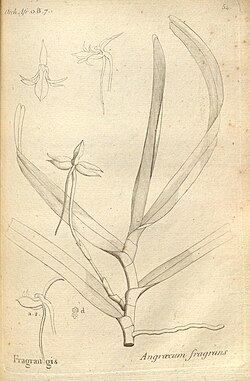Biology:Jumellea fragrans
| Jumellea fragrans | |
|---|---|

| |
| 1891 illustration (as Angraecum fragrans) from Curtis's botanical magazine Volume 117 | |

| |
| Botanical illustration of Jumellea fragrans as Angraecum fragrans | |
| Scientific classification | |
| Kingdom: | Plantae |
| Clade: | Tracheophytes |
| Clade: | Angiosperms |
| Clade: | Monocots |
| Order: | Asparagales |
| Family: | Orchidaceae |
| Subfamily: | Epidendroideae |
| Genus: | Jumellea |
| Species: | J. fragrans
|
| Binomial name | |
| Jumellea fragrans (Thouars) Schltr.
| |

| |
| Jumellea fragrans is native to Mauritius and Réunion[1] | |
| Synonyms[1] | |
| |
Jumellea fragrans, also known as faham,[2][3] is a species of orchid in the genus Jumellea. It is native to the islands of Mauritius and Réunion.[1]
Ecology
It grows as an epiphyte in the lowland rain forest up to 500 m above sea level. [4]
Description
The species blooms in March-April with a single flowered inflorescence with 3 basal bracts. [5] The flower has a spur of approximately 39 mm long and is pollinated by hawk moths. [6]
Taxonomy
Differentiation from Jumellea rossii
These two similar species can be confused. Jumellea rossii occurs at high altitudes, whereas Jumellea fragrans occurs at lower elevations.[2] Three important diagnostic characters for species delimitation have been identified: The length of the spur, the leaf length, as well as the leaf width:[7]
| Species | Spur length[7] | Leaf length[7] | Leaf width[7] |
|---|---|---|---|
| Jumellea fragrans | >30 mm | >85 mm | >14 mm |
| Jumellea rossii | <30 mm | <85 mm | <14 mm |
Phylogeny
Jumellea fragrans is the sister group to Jumellea rossii. It is also closely related to Jumellea tenuibracteata, Jumellea francoisii, and Jumellea alionae, as can be seen in the following cladogram:[8]
| |||||||||||||||||||||||||||||||
Uses
The fragrant leaves and flowers are boiled in hot water to extract its aromatic qualities. This is used to flavour rum on Reunion Island. Other uses that have fallen out of favour include digestive aid, remedy for respiratory disease, ice cream and custards.[5] The plant's use for medicinal purposes on Mauritius is thought to be critically endangered.[9]
Conservation
It is threatened due to unsustainable overcollection in wild habitats and lack of agricultural production.[2] It is recommended to categorize Jumellea fragrans as vulnerable (VU) under the IUCN Red List criteria.[7]
Physiology
Coumarin, and two groups of diterpenes (kaurenes, phytadienes) have been isolated from this species foliage.[3]
References
- ↑ 1.0 1.1 1.2 "Jumellea fragrans". Royal Botanical Gardens Kew. https://powo.science.kew.org/taxon/urn:lsid:ipni.org:names:639365-1.
- ↑ 2.0 2.1 2.2 Laury Blambert. "Biologie et chimie des jumellea aromatiques de la Réunion : application à la conservation et à la valorisation des espèces." Biodiversité et Ecologie. Université de la Réunion, 2016. Français. NNT: 2016LARE0034. tel-01525694
- ↑ 3.0 3.1 Sing, A. S. C., Smadja, J., Brevard, H., Maignial, L., Chaintreau, A., & Marion, J. P. (1992). "Volatile constituents of faham (Jumellea fragrans (Thou.) Schltr.)." Journal of Agricultural and Food Chemistry, 40(4), 642-646.
- ↑ Blambert, Laury (March 2016). "Reproductive patterns, genetic diversity and inbreeding depression in two closely related Jumellea species with contrasting patterns of commonness and distribution". Annals of Botany 118 (1): 93–103. doi:10.1093/aob/mcw014. PMID 26944785.
- ↑ 5.0 5.1 "Jumellea fragrans (Thouars) Schltr. 1914". http://www.orchidspecies.com/jumfragrans.htm.
- ↑ Mallet, B. (2014). Effet de l'habitat et des pollinisateurs sur la diversification du faham (Jumellea spp., Orchidaceae) aux Mascareignes.. France: Université de la Réunion.
- ↑ 7.0 7.1 7.2 7.3 7.4 Bertrand Mallet, Laurence Humeau, Laury Blambert, Fanny Rakotoarivelo, Claudia Baider, et al.. Différences morphologiques et identification de Jumellea rossii et Jumellea fragrans (Orchidaceae) à l’île de La Réunion : implications pour la conservation. Revue d’Ecologie, Terre et Vie, 2012, Sup11, pp.73-84. hal-03530468
- ↑ Rakotoarivelo, F. P., Razafimandimbison, S. G., Mallet, B., Faliniaina, L., & Pailler, T. (2012). "Molecular systematics and evolutionary trends and relationships in the genus Jumellea (Orchidaceae): implications for its species limits." Taxon, 61(3), 534-544.
- ↑ "Newsletter of the Medicinal Plant Specialist Group of the IUCN Species Survival Commission". IUCN. May 2012. https://www.iucn.org/sites/dev/files/import/downloads/mpc_15_1.pdf.
Wikidata ☰ Q3064445 entry
 |

